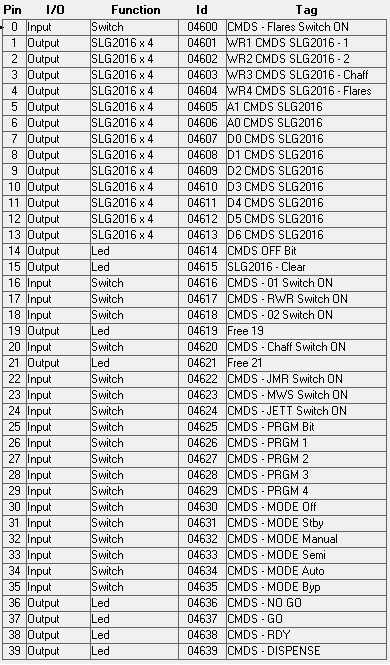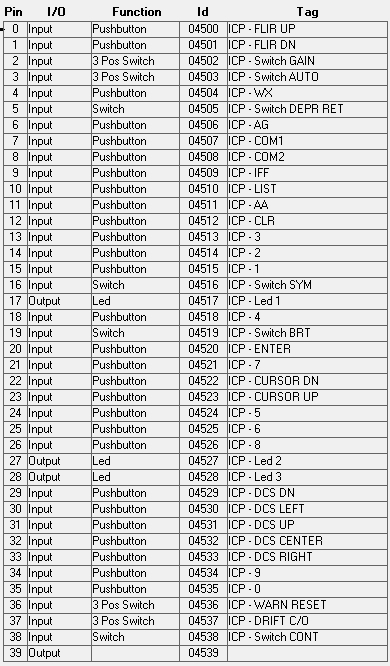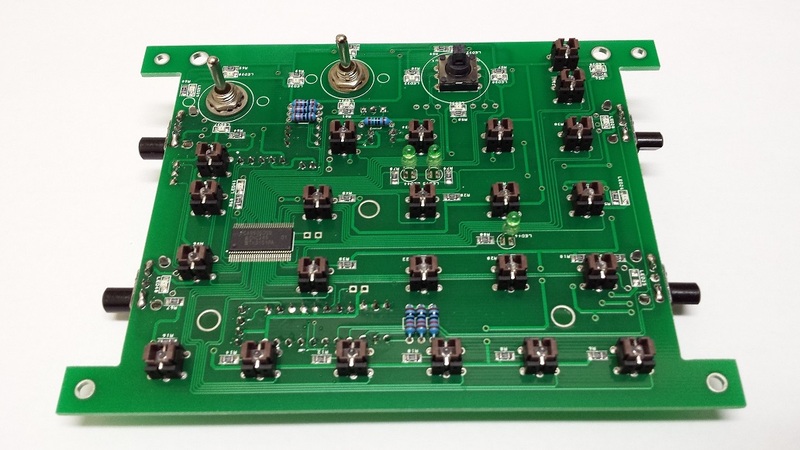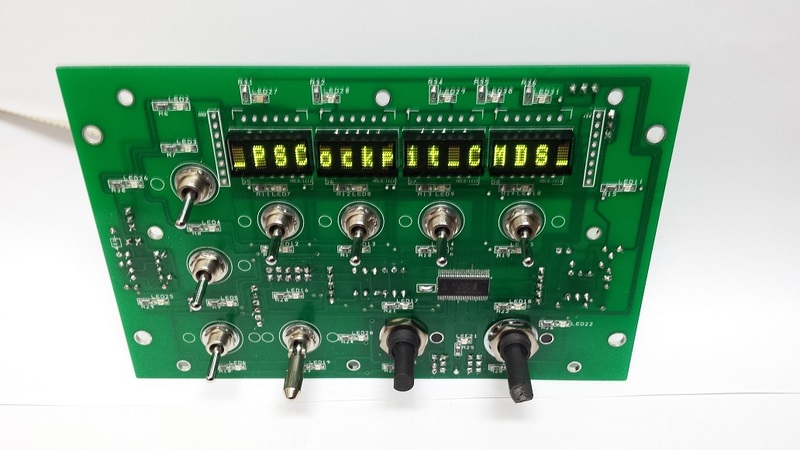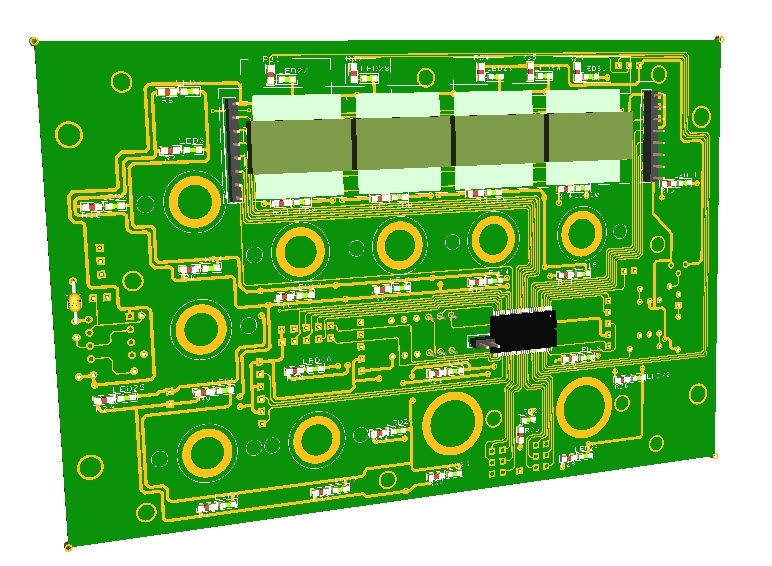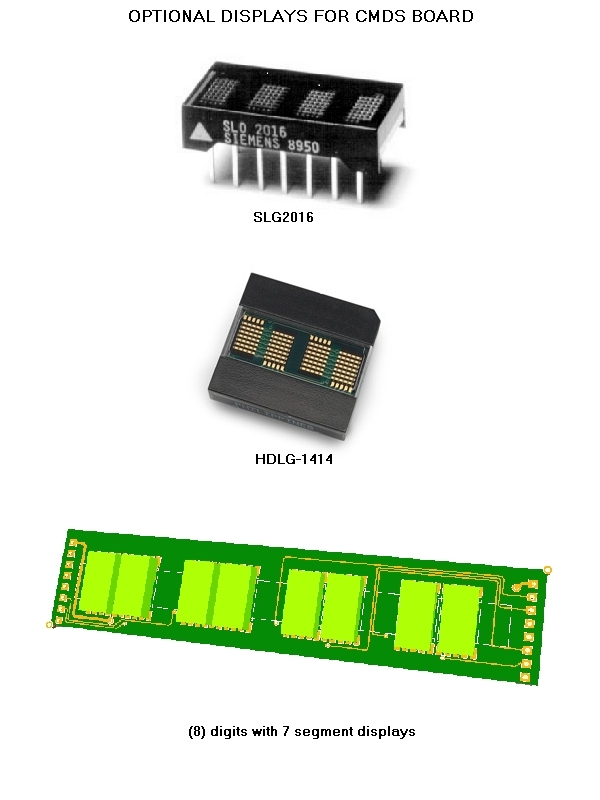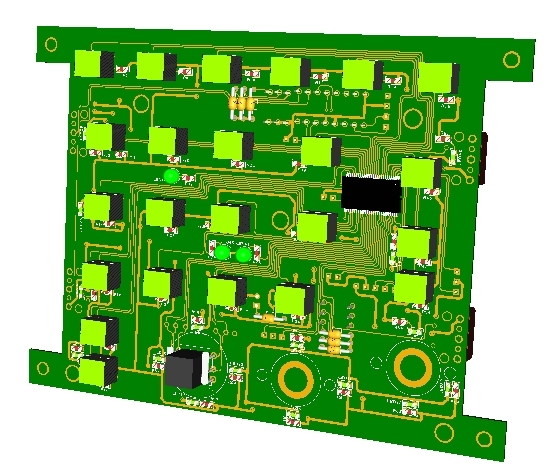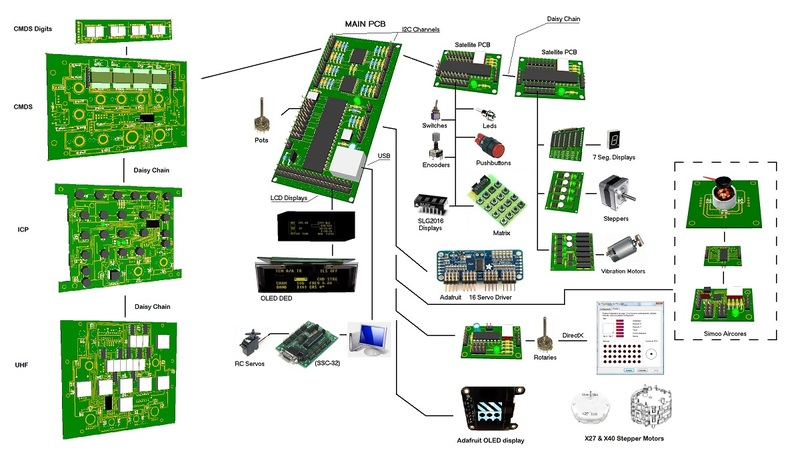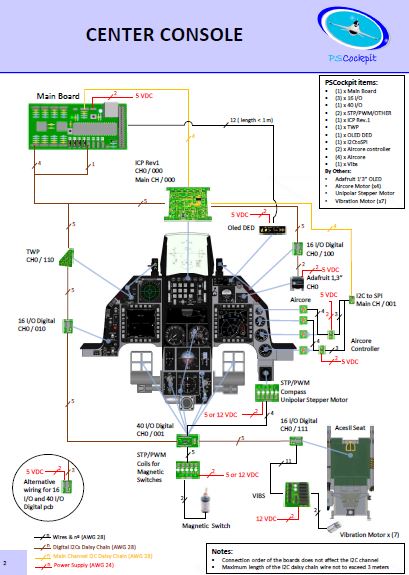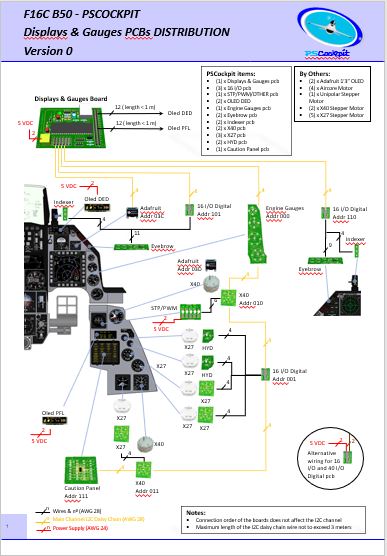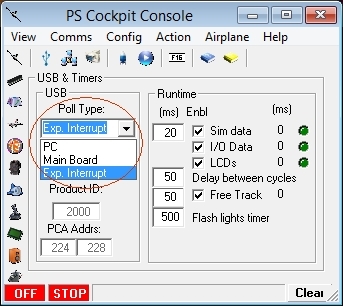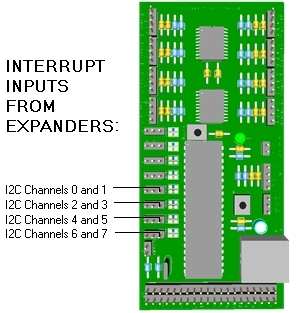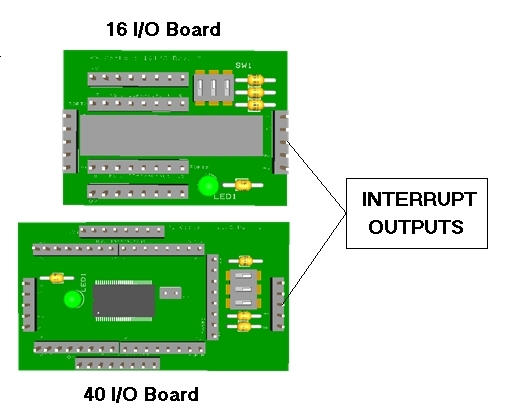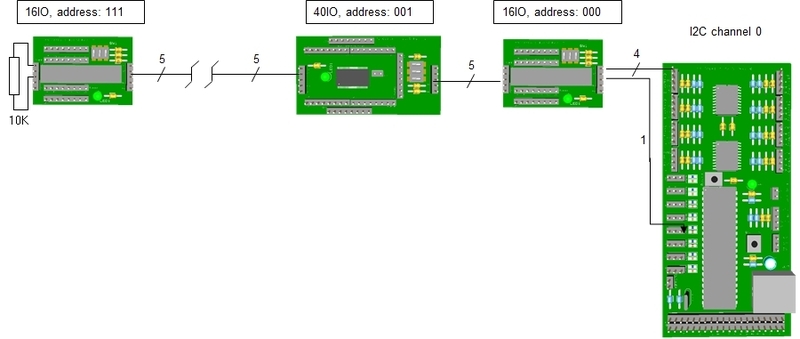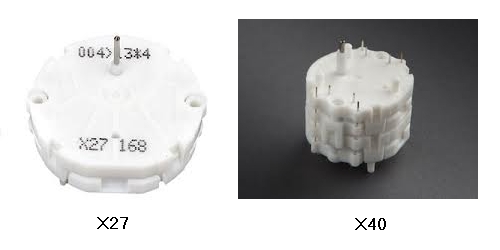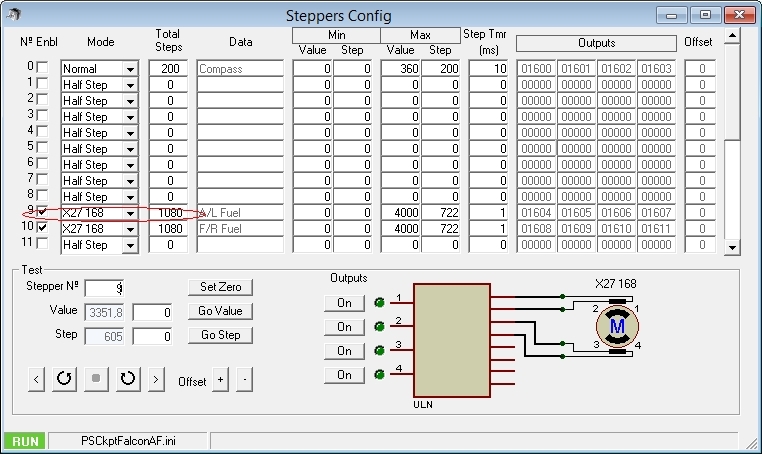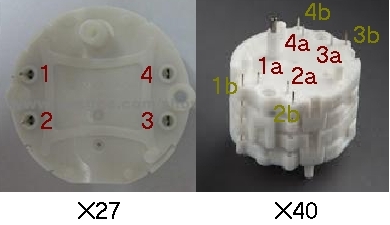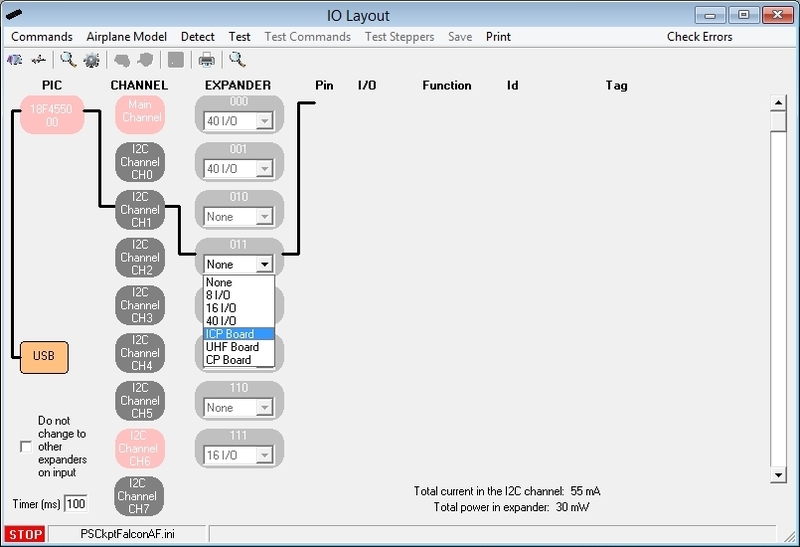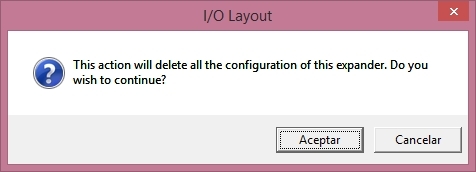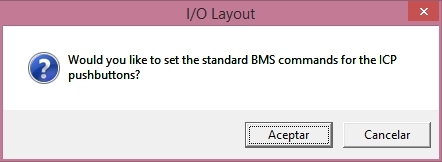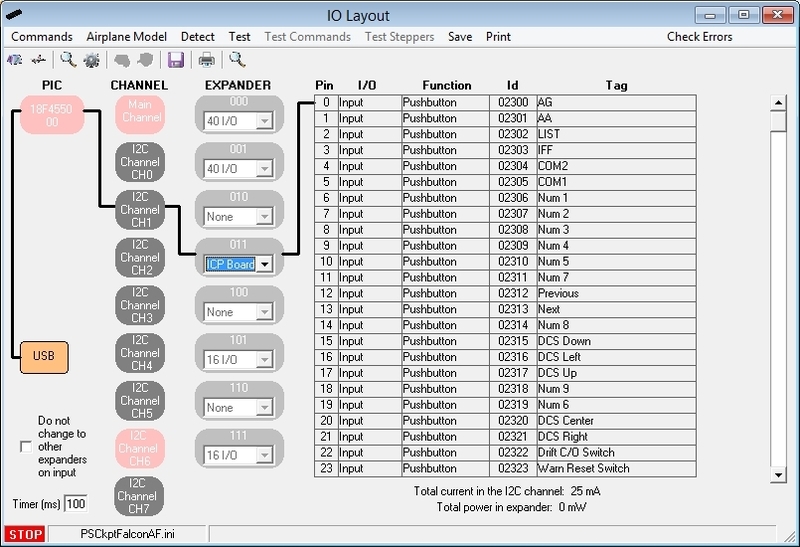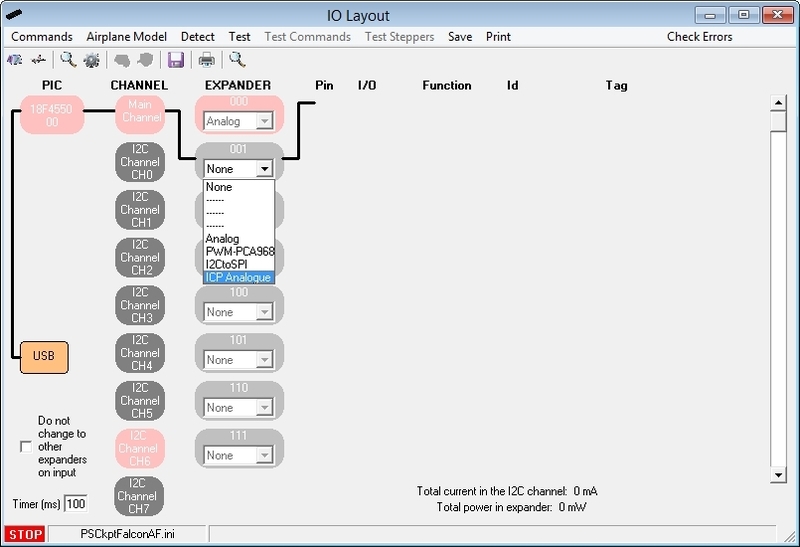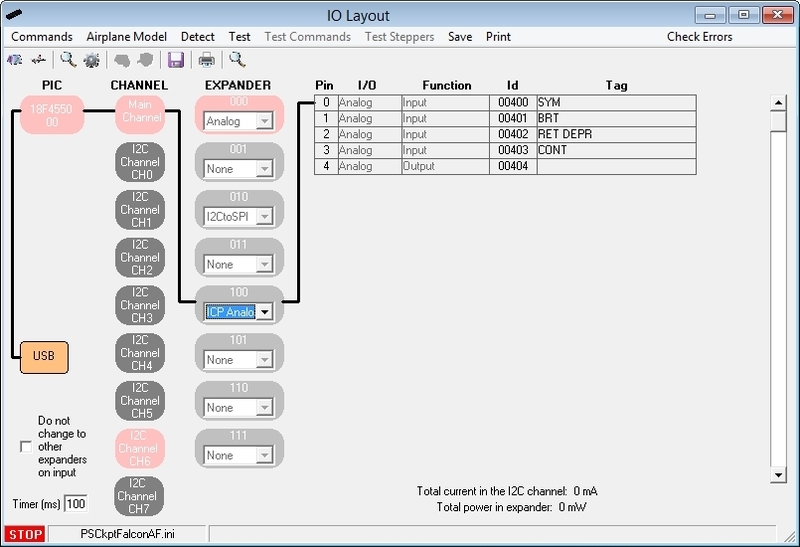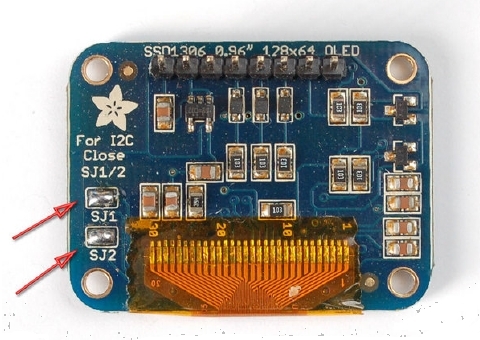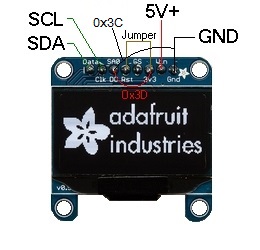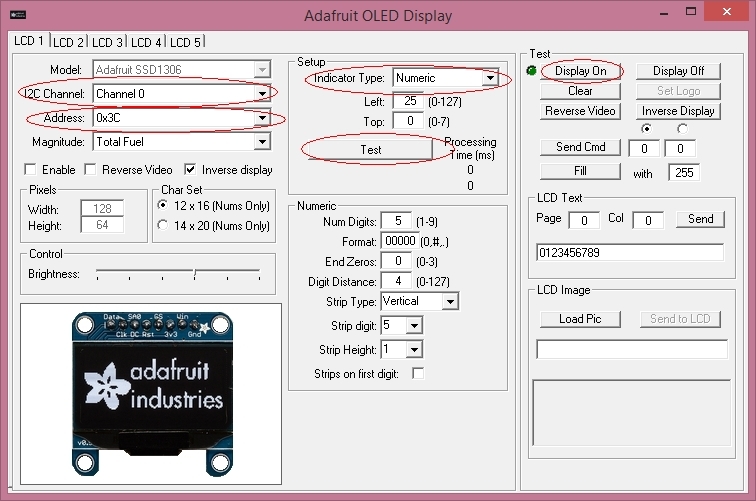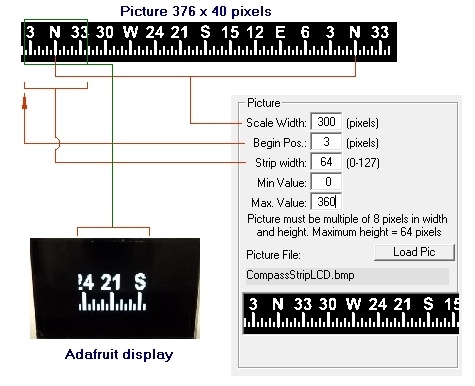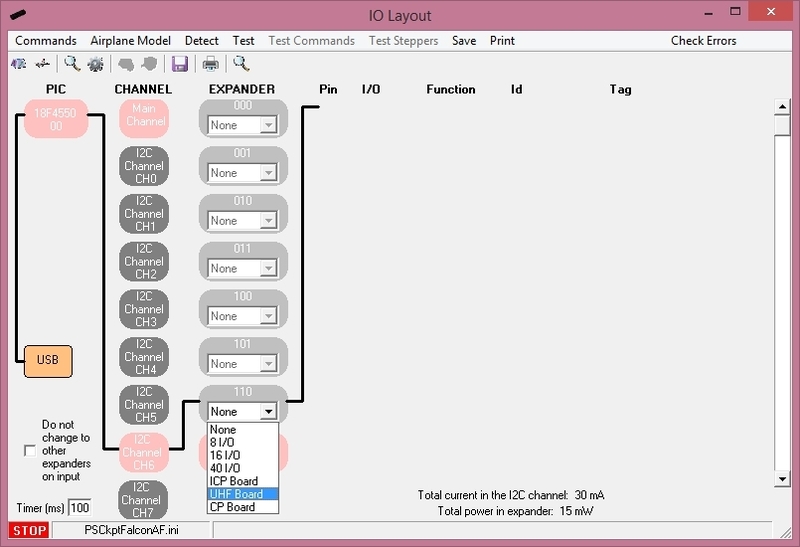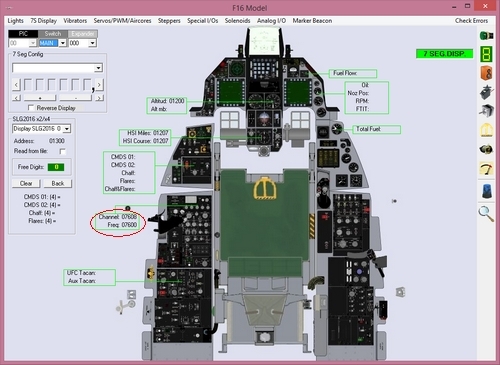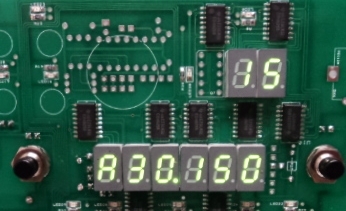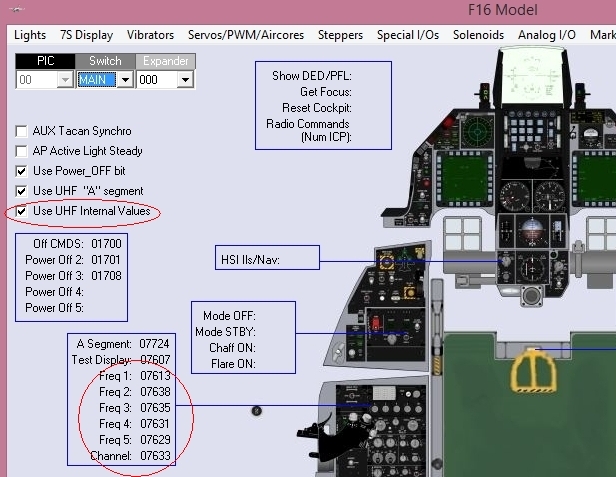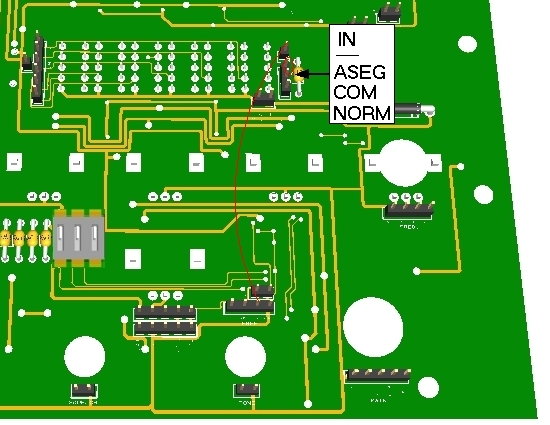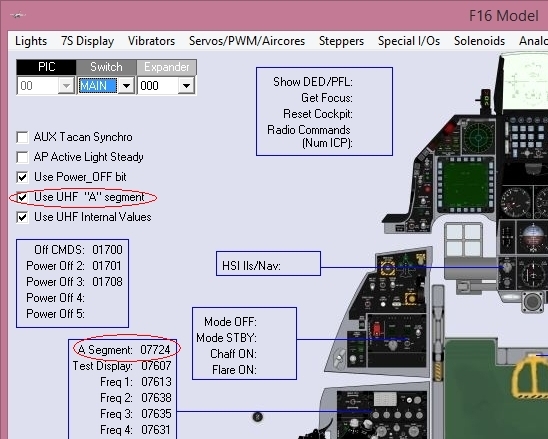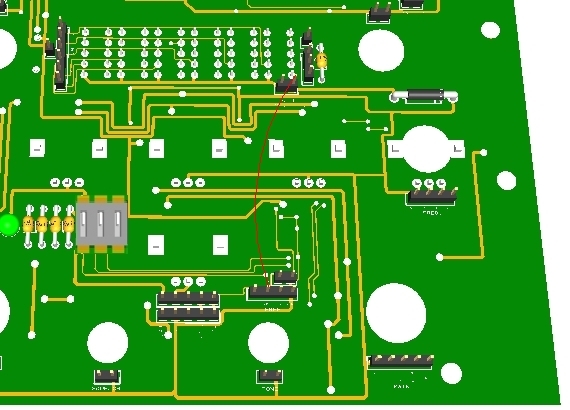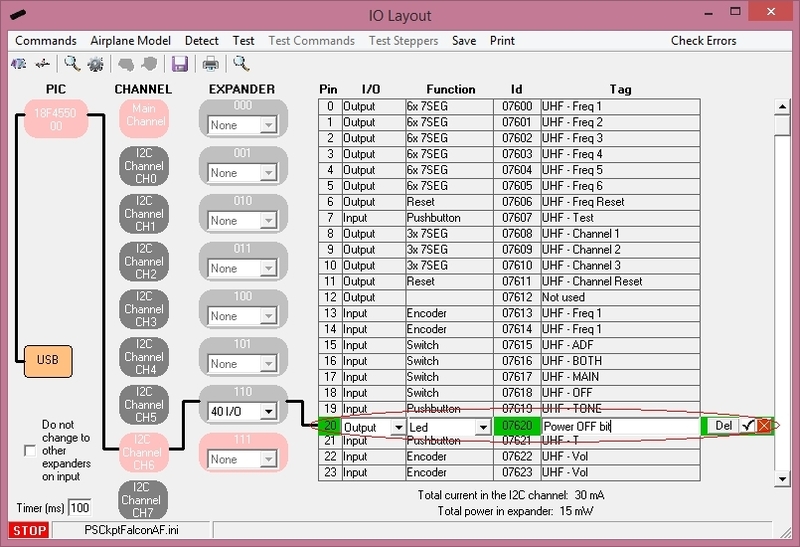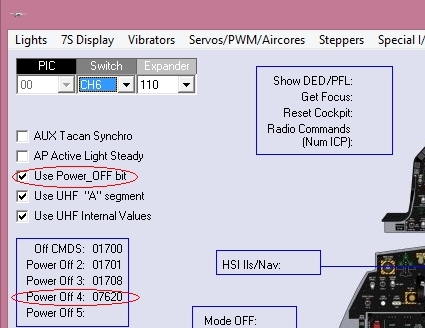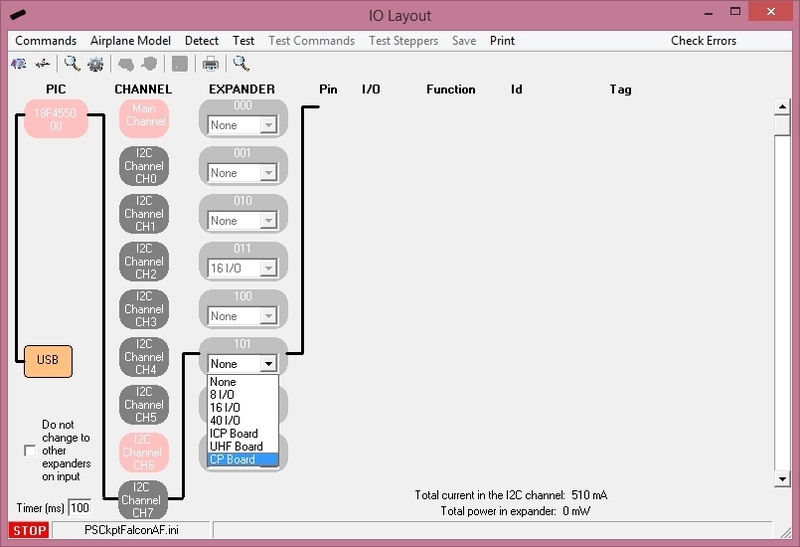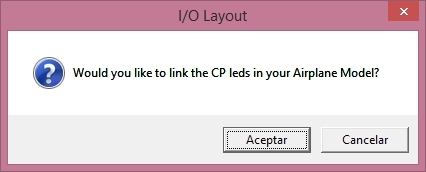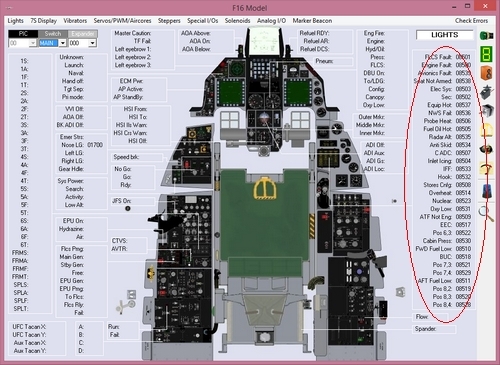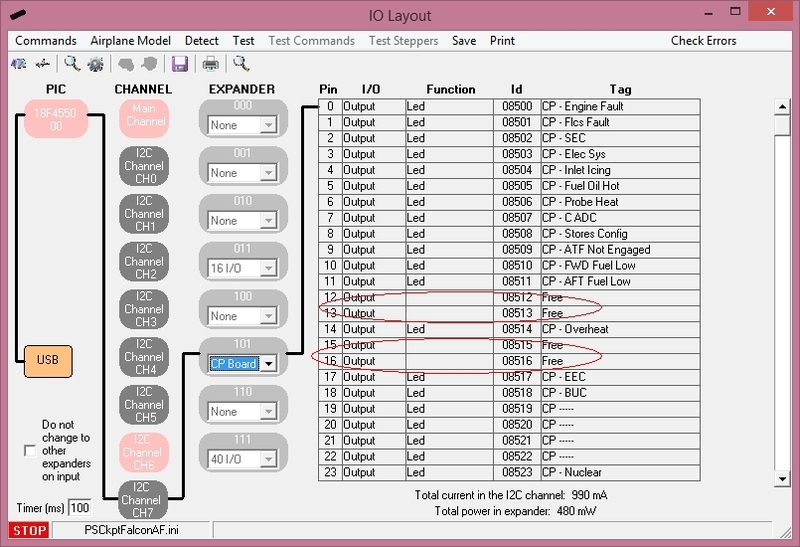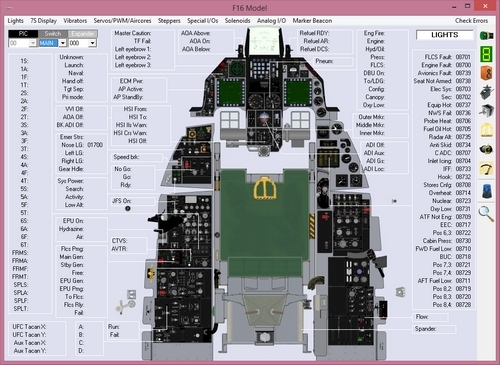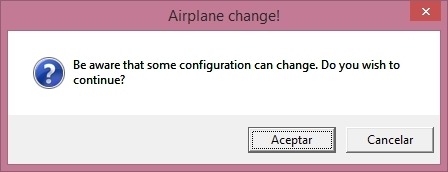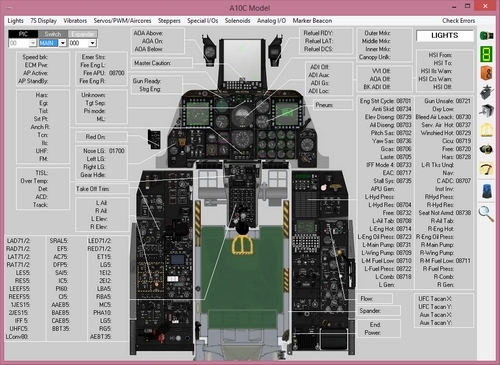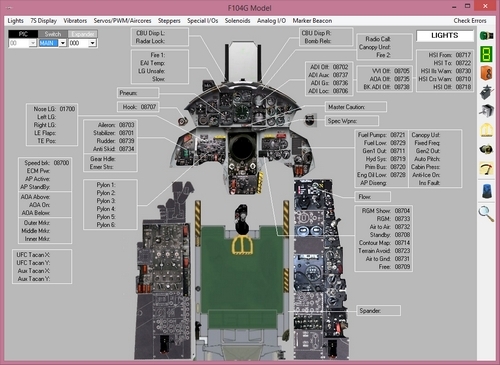Hi everybody,
Some shimpents are on the way and I will ship the rest of your orders in the following two weeks.
For the ones that have already the ICPRev1 board, be aware that the current ICP configuration of the PSCockpit Software is not valid. The new one for ICPRev1 and CMDS boards will come with the next software revisión.
If any of you want to configure them by yourselves, here is the pinout of both boards:
Saturday, December 12, 2015
Sunday, November 22, 2015
CMDS and ICP Rev1 Boards
Hello everybody!
Some pictures of the full CMDS and ICP Rev.1 boards already assembled:
One note on the ICP Rev.1:
I found that the switch of the thumbwheel pots are located on the upper side of the thumbwheel so I've decided to replace them with normal pots. To simulate the switch I've added an option in the PSCockpit software.
Still some items and pcbs to be received this week but I will begin to deliver the boards next week.
Regards,
Shep
Some pictures of the full CMDS and ICP Rev.1 boards already assembled:
One note on the ICP Rev.1:
I found that the switch of the thumbwheel pots are located on the upper side of the thumbwheel so I've decided to replace them with normal pots. To simulate the switch I've added an option in the PSCockpit software.
Still some items and pcbs to be received this week but I will begin to deliver the boards next week.
Regards,
Shep
Monday, November 2, 2015
PSCockpit Quick Update for BMS 4.33
Hi everybody,
You can download versión 0.9.8 of the PSCockpit Software at: PSCockpit V0.9.8 Download
It is a quick Update executable for BMS 4.33!!
Just unzip and copy PSCockpit.exe to your PSCockpit directory.
CHANGELOG V 0.9.8 (WIP)
=====================
- Added BMS 4.33 new Shared Memory values: Altimeter barometric altitud, Altimeter pneumatic flag, Backup UHF channel and frequency, Cabin Pressure, Hydraulic Pressure A and B, Current time, Vehicle ACD.
- Added BMS 4.33 new Shared Memory Values to A10 Model: Fuelflow2, rpm2, ftit2, Oilpress2.
- Pitch and roll trim added to the F16 Model in the servo section.
- Added inverse POWER_OFF bits outputs
- Corrected bug in .key file modifiers (Commands)
- Added "Reset UI" command in the System Tray Menu to reset PSCockpit UI when it is not visible.
- Corrected a bug with arrow keys scan codes (Commands)
- Added the posibility to map your own key scan code (Commands)
Regards,
Shep
You can download versión 0.9.8 of the PSCockpit Software at: PSCockpit V0.9.8 Download
It is a quick Update executable for BMS 4.33!!
Just unzip and copy PSCockpit.exe to your PSCockpit directory.
CHANGELOG V 0.9.8 (WIP)
=====================
- Added BMS 4.33 new Shared Memory values: Altimeter barometric altitud, Altimeter pneumatic flag, Backup UHF channel and frequency, Cabin Pressure, Hydraulic Pressure A and B, Current time, Vehicle ACD.
- Added BMS 4.33 new Shared Memory Values to A10 Model: Fuelflow2, rpm2, ftit2, Oilpress2.
- Pitch and roll trim added to the F16 Model in the servo section.
- Added inverse POWER_OFF bits outputs
- Corrected bug in .key file modifiers (Commands)
- Added "Reset UI" command in the System Tray Menu to reset PSCockpit UI when it is not visible.
- Corrected a bug with arrow keys scan codes (Commands)
- Added the posibility to map your own key scan code (Commands)
Regards,
Shep
Friday, September 25, 2015
CMDS board
The following components are also inlcuded:
- (25) SMD leds for lettering backlight.
- (2) SMD leds for GO and NO GO indication.
- (3) SMD leds for DISPENSE READY indication
- (1) Rotary switch with 5 positions 45º
- (1) Rotary switch with 6 positions 30º
You will find the following elements in the backside:
- (1) Connector for backlight illumination.
- (1) Connector for digital I/O I2C channel,
- (1) Miniswitch to select digital I2C channel address
- (1) Connector for7 free digital I/Os of the 40 I/O board.
- (1) Selectable connector for dimmer/CMDS_OFF bit
To complete the CMDS board, it can be supplied with the optional following elements:
- (8)Mini Toggle ON-OFF switches of 6 mm diameter. One of them comes with a locking lever for the JETT switch. Be aware that these switches are smaller than the real ones.
- SLG2016 displays, or
- HDGL-1414 displays, or
- 7 Segment display board with 8 digits of 4.22 x 7.62 mm
If you select the CMDS board with the switches and one of the displays options you will only have to add by yourself the CMDS case and the PRGM and MODE knobs for the rotary switches.
Please check the dimensions for the CMDS case at:
Link
Regards,
Shep
Please check the dimensions for the CMDS case at:
Link
Regards,
Shep
ICP BOARD Rev1
The new ICP Rev.1 board has been designed with (1) 40 I/O chip and (1) analogue chip that can be connected to the digital I/O I2C channel and the I2C analogue channel of the PSCockpit system. It comes with corresponding elements (resistors, connectors, …) to work with 5V and two selectable mini-switches to select the desire I2C addresses.
Also included are the following components:
- (23) Mini switches with internal leds for pushbutton backlight. The leds are connected to the backlight circuit to allow “dimmering”.
- (16) SMD leds for lettering backlight.
- (1) Mini joystick. The board has been carefully designed so you can remove the mini joystick, drill the board and place you own joystick
- (3) frontal leds
- (2) Mini-toggle switches Drift C/O and Gain. You can remove this toggle switches, drill the board up to 14mm.diam and place you own toggle switches.
- (4) 100K pots for side wheels with ON/OFF switch. These pots can be removed and changed with encoders.
You will find the following elements in the backside:
- (1) Connector for backlight illumination.
- (1) Connector for digital I/O I2C channel,
- (1) Connector for analogue I2C channel
- (1) Miniswitch to select digital I2C channel address
- (1) Miniswitch to select analogue I2C channel address
- (1) Connector for1 free digital I/O of the 40 I/O board.
To complete the ICP you will have to add by yourself the following elements:
- IPC case and pushbuttons
- Side wheels. As the pots are in the backside of the board the recommended wheel diameter is 44mm
Please check the following dimensions for the ICP case: http://www.mediafire.com/download/z4972pne2vhjcc0/IPCRev1-A3.pdf
Regards,
Shep
Also included are the following components:
- (23) Mini switches with internal leds for pushbutton backlight. The leds are connected to the backlight circuit to allow “dimmering”.
- (16) SMD leds for lettering backlight.
- (1) Mini joystick. The board has been carefully designed so you can remove the mini joystick, drill the board and place you own joystick
- (3) frontal leds
- (2) Mini-toggle switches Drift C/O and Gain. You can remove this toggle switches, drill the board up to 14mm.diam and place you own toggle switches.
- (4) 100K pots for side wheels with ON/OFF switch. These pots can be removed and changed with encoders.
You will find the following elements in the backside:
- (1) Connector for backlight illumination.
- (1) Connector for digital I/O I2C channel,
- (1) Connector for analogue I2C channel
- (1) Miniswitch to select digital I2C channel address
- (1) Miniswitch to select analogue I2C channel address
- (1) Connector for1 free digital I/O of the 40 I/O board.
To complete the ICP you will have to add by yourself the following elements:
- IPC case and pushbuttons
- Side wheels. As the pots are in the backside of the board the recommended wheel diameter is 44mm
Please check the following dimensions for the ICP case: http://www.mediafire.com/download/z4972pne2vhjcc0/IPCRev1-A3.pdf
Regards,
Shep
Tuesday, September 22, 2015
PSCockpit System 5th Run
Time to launch a new run of the PSCockit System!! 
In this run the following new boards have been developed:
- ICP pcb, revision 1.
- CMDS pcb
- CMDS 7 segment display digits
Description
- One stop hardware and software for cockpit systems. Once the cockpit is connected you can configure the software individually for each sim.
- Easy configuration and setup for people with out electronic knowledge.
- Avoid excessive wiring runs along the cockpit.
The system uses small satellite PCB’s that can be distributed along the cockpit. The communication between these satellite PCB’s and the Main PCB is done with only 2 wires (I2C protocol) plus the power cables. These wires can be connected in daisy chain. The idea is to wire each of the cockpit panels to only one satellite PCB.
More information, downloads and guides at http://psfalcon.blogspot.com.es/2015/05/pscockpit-system-up-to-date-software.html
Pricing and ordering information at:
http://www.viperpits.org/smf/index.php/topic,10254.0.HTML
Regards,
Shep

In this run the following new boards have been developed:
- ICP pcb, revision 1.
- CMDS pcb
- CMDS 7 segment display digits
PSCockpit System 5th Run!!!
Description
- One stop hardware and software for cockpit systems. Once the cockpit is connected you can configure the software individually for each sim.
- Easy configuration and setup for people with out electronic knowledge.
- Avoid excessive wiring runs along the cockpit.
The system uses small satellite PCB’s that can be distributed along the cockpit. The communication between these satellite PCB’s and the Main PCB is done with only 2 wires (I2C protocol) plus the power cables. These wires can be connected in daisy chain. The idea is to wire each of the cockpit panels to only one satellite PCB.
More information, downloads and guides at http://psfalcon.blogspot.com.es/2015/05/pscockpit-system-up-to-date-software.html
Pricing and ordering information at:
http://www.viperpits.org/smf/index.php/topic,10254.0.HTML
Regards,
Shep
Sunday, May 3, 2015
PSCockpit System Up to Date Software, Firmware, Guides and Boards
NEXT RUN EXPECTED DATE: Ongoing
PSCOCKPIT SYSTEM
SYSTEM DESCRIPTION
- General overview: Link
SOFTWARE:
- Last auto installable version PSCockpit Software v 1.0.6u2: PSCockpit Software Last Version
FIRMWARE:
- Last firmware version PSCockit Firmware v1.6.6: Firmware Last Version
QUICK GUIDE:
- Last quick guide version PSCockpit Quick Guide v7: Quick Guide
PCBs DISTRIBUTION SHEET EXAMPLES:
- F16 Block 52 with PSCockpit Main Board + Disp&Gauges: F-16 Distribution File D&G
- F16 Block 52: F-16 Distribution File
- A10C: A-10 Distribution File
HOW TO’s:
- List of all PSCockpit HOW TO’s: http://psfalcon.blogspot.com.es/2015/05/list-of-all-pscockpit-system-how-tos_2.html
PAST RUN POSTS:
- First run post: http://viperpits.org/smf/index.php?topic=7237.0
- Second run post: http://www.viperpits.org/smf/index.php?topic=8679.0
- Third run post: http://www.viperpits.org/smf/index.php?topic=9235.0
- Four run post: http://www.viperpits.org/smf/index.php/topic,9774.0.html
- Fifth run post: http://www.viperpits.org/smf/index.php/topic,10254.0.html
- Sixth run post: http://www.viperpits.org/smf/index.php/topic,10715.msg156116.html#msg156116
- Seventh run post: http://www.viperpits.org/smf/index.php?topic=11042.0
- Eight run post: http://www.viperpits.org/smf/index.php?topic=11294.0
- Nine run post: http://www.viperpits.org/smf/index.php?topic=11629.0
CURRENT DEVELOPED BOARDS:
- Main PCB
- Digital expander for 40 inputs/outputs
- Digital expander 16 inputs/outputs
- Steppers/Other voltage outputs pcb
- 7 segment displays pcb for 6 displays
- Analogue pcb for 4 inputs/1 output
- OLED display (85mm x 40mm), 256x64 for DED
- I2CtoSPI pcb
- Aircore Controller pcb
- Aircore pcb
- Vibration motors pcb
- I/O Enhancement pcb
Quasi complete boards:
- ICP board (deprecated). See ICP Rev1 board
- Caution Panel board
- UHF board
- CMDS board
- ICP Rev1 board
- X40 board for X40 steppers
- TWP board
- TWA board
- PWM board
- ELEC board
- AUDIO1 and AUDIO2 board.
NEW DEVELOPMENTS PENDING:
- A10C UFC board
- A10C CDU board
- Caution Panel Extension board (A10C)
PSCOCKPIT DISPLAYS AND GAUGES SYSTEM:
Regards,
Shep
- F16 Block 52: F-16 Distribution File
- A10C: A-10 Distribution File
HOW TO’s:
- List of all PSCockpit HOW TO’s: http://psfalcon.blogspot.com.es/2015/05/list-of-all-pscockpit-system-how-tos_2.html
PAST RUN POSTS:
- First run post: http://viperpits.org/smf/index.php?topic=7237.0
- Second run post: http://www.viperpits.org/smf/index.php?topic=8679.0
- Third run post: http://www.viperpits.org/smf/index.php?topic=9235.0
- Four run post: http://www.viperpits.org/smf/index.php/topic,9774.0.html
- Fifth run post: http://www.viperpits.org/smf/index.php/topic,10254.0.html
- Sixth run post: http://www.viperpits.org/smf/index.php/topic,10715.msg156116.html#msg156116
- Seventh run post: http://www.viperpits.org/smf/index.php?topic=11042.0
- Eight run post: http://www.viperpits.org/smf/index.php?topic=11294.0
- Nine run post: http://www.viperpits.org/smf/index.php?topic=11629.0
- Tenth run post: PSCockpit System 10th Run: Displays & Gauges PCB! (viperpits.org)
- Eleventh run post: PSCockpit and PSCockpit Displays&Gauges Systems 11th Run!!! (viperpits.org)
- Twelfth run post: https://www.viperpits.org/smf/index.php?topic=12568.0
- Thirteenth run post: https://www.viperpits.org/smf/index.php?topic=12768.0
CURRENT DEVELOPED BOARDS:
- Main PCB
- Digital expander for 40 inputs/outputs
- Digital expander 16 inputs/outputs
- Steppers/Other voltage outputs pcb
- 7 segment displays pcb for 6 displays
- Analogue pcb for 4 inputs/1 output
- OLED display (85mm x 40mm), 256x64 for DED
- I2CtoSPI pcb
- Aircore Controller pcb
- Aircore pcb
- Vibration motors pcb
- I/O Enhancement pcb
- X27 pcb for X27 Stepper motor or Aircore motor
- HYD pcb for X27 Stepper motor or Aircore motor
- Indexer lights AOA and NWS pcb
- Left and right Eyebrow lights pcb
- CPD pcbs
- EHSI pcb
Quasi complete boards:
- ICP board (deprecated). See ICP Rev1 board
- Caution Panel board
- UHF board
- CMDS board
- ICP Rev1 board
- X40 board for X40 steppers
- TWP board
- TWA board
- PWM board
- ELEC board
- AUDIO1 and AUDIO2 board.
NEW DEVELOPMENTS PENDING:
- A10C UFC board
- A10C CDU board
- Caution Panel Extension board (A10C)
PSCOCKPIT DISPLAYS AND GAUGES SYSTEM:
SYSTEM DESCRIPTION
- System description: Link
SOFTWARE:
- Last version Displays&Gauges Software V1.0.2: Link
FIRMWARE:
- Last firmware version Displays&Gauges: Firmware v1.0.1. See Help/Firmware update on your Displays&Gauges software.
QUICK GUIDE:
- Last quick guide version PSCockpit Displays&Gauges v0.
PCBs DISTRIBUTION SHEET:
- F16 Block 52 with PSCockpit Main Board + Disp&Gauges: F-16 Distribution File D&G
ALL POSTS:
- All posts: PS Tools: Displays & Gauges (psfalcon.blogspot.com)
Regards,
Shep
Saturday, May 2, 2015
LIST OF ALL PSCOCKPIT SYSTEM HOW TO’s:
General
PSCockpit PCB system - General overview
HOW TO Poll the I/O expanders
Digital inputs
HOW TO Interface 3 Positions Switches
HOW TO Use Rotary Encoders
HOW to Use the New Encoder Interface Option
HOW TO Encoding/Multiplexing
Digital Outputs
HOW TO Use 7 Segment Displays
HOW TO Use 5x7 Dot Matrix AlphanumericIntelligent Display SLG2016
HOW TO Implement the Magnetic Held Switches
HOW TO Use AIRCORES in PSCockpit System
Steppers
Displays
Analogue inputs
Complete boards
Backlighting Leds PWM board
A10C UFC and CDU Boards (not developed)
Miscellaneous
HOW TO Assign Key Strokes to Different Programs (Launcher)
HOW TO Get Your Tacan Channels Working
HOW TO Use POWER_OFF Bit
HOW TO Assign commands
HOW TO Assign Commands Directly From yourBMS .key File
HOW TO Configure the Marker Beacon
HOW TO use and configure vJoy in PSCockpit
Firmware
HOW TO Upgrade the Main Board firmware
Other software
PS Keys for Falcon
PS UDP Falcon Server for Android 4.0"
A10C UFC and CDU Boards (not developed)
Miscellaneous
HOW TO Assign Key Strokes to Different Programs (Launcher)
HOW TO Get Your Tacan Channels Working
HOW TO Use POWER_OFF Bit
HOW TO Assign commands
HOW TO Assign Commands Directly From yourBMS .key File
HOW TO Configure the Marker Beacon
HOW TO use and configure vJoy in PSCockpit
Firmware
HOW TO Upgrade the Main Board firmware
Other software
PS Keys for Falcon
PS UDP Falcon Server for Android 4.0"
PSCockpit Quick Guide v3
Sunday, April 5, 2015
PS Cockpit Software V.0.9.7 Update
The new version V.0.9.7 of the PS Cockpit Software is available for download!!
PS Cockpit Software V.0.9.7 Changelog:
- Added UHF board and CP board self-configuration (IOLayOut)
- Added UHF Frequency and Channel internal values (Airplane Models)
- Added 0x7A and 0x78 addresses for OLED 1.3" (Adafruit OLED)
- Added On-line HOW TOs (General Settings)
- Added Quick Guide v3 (General Settings)
- Check Errors between Airplane Model and IOLayOut implemented (Airplane Models and IOLayOut)
- Added FTIT range value missing
- Corrected the bug of running the program while no Main Board is connected (window hook).
- CMDS functions on low chaffs and flares corrected
- CMDS works on SGL2016 displays as real
- Steppers X27 168 and X40 added. Only for low speed indicators with no different scales. (Airplane Models)
- Adafruit OLED 1.8" implemented (General Settings)
- Run time cycle improved
- Auto poll chip and I/O expander interrupt implemented (USB Timers)
You can download it at: Download
To update the firmware of the Main Board, visit: PS Cockpit Firmware Update
Thanks all for your patient!!!
Regards,
Shep
PS Cockpit Software V.0.9.7 Changelog:
- Added UHF board and CP board self-configuration (IOLayOut)
- Added UHF Frequency and Channel internal values (Airplane Models)
- Added 0x7A and 0x78 addresses for OLED 1.3" (Adafruit OLED)
- Added On-line HOW TOs (General Settings)
- Added Quick Guide v3 (General Settings)
- Check Errors between Airplane Model and IOLayOut implemented (Airplane Models and IOLayOut)
- Added FTIT range value missing
- Corrected the bug of running the program while no Main Board is connected (window hook).
- CMDS functions on low chaffs and flares corrected
- CMDS works on SGL2016 displays as real
- Steppers X27 168 and X40 added. Only for low speed indicators with no different scales. (Airplane Models)
- Adafruit OLED 1.8" implemented (General Settings)
- Run time cycle improved
- Auto poll chip and I/O expander interrupt implemented (USB Timers)
You can download it at: Download
To update the firmware of the Main Board, visit: PS Cockpit Firmware Update
Thanks all for your patient!!!
Regards,
Shep
PS Cockpit System F16 distribution file
You can download the F16 Cockpit Rev.1 distribution file in pdf format at:
http://www.mediafire.com/download/ww3sfnmyhtv1dhz/F16-PSCockpitDistribution.pdf
And the distribution list in excel format at:
http://www.mediafire.com/download/98x5860vpiykbbn/PSCockpitDistREV1.rar
Regards,
Shep
PS Cockpit Firmware Update
The new
firmware V 1.6.0 for the PS Cockpit Main Boards is available for download!!
PS Cockpit
System Firmware V.1.6.0 Changelog:
- Microchip
bootloader for W7&8 64 bits (4th Run Main Boards and later)
- PSCockpit
logo removed from the OLED displays- New RUN modes: Auto Poll and Expanders Interrupt
- Added control for Adafruit OLED 1.3" (SSD1306)
- Added control for steppers X27-168 and X40 double steppers
You can download
the firmware at: Download
Tools for
upgrading the firmware:
-
Users
of the PS Cockpit Main Boards of the 4th Run can update the
firmware in 64bits Windows operating system (These users do not need to update
the firmware by now) with PSFirmUpdtV2-4thRunMainBoards
- Users of the PS Cockpit Main Boards of previous runs can only update the firmware in 32 bits Windows operating systems PSFirmUpdtV1-PreviousMainBoards tool.
Do not try to update the firmware with the
incorrect tool version!!! It will ruin the firmware. If you have any doubt about your Main Board
tool please send me an email.
Regards,
ShepSaturday, April 4, 2015
HOW TO Poll the PS Cockpit Expanders
Since PS Cockpit Software V.0.9.7 and firmware version 1.6.0 you can poll the I/O expanders in three different ways:
- PC Mode: In this mode PC is responsible to check all the boards in a given cycle.
- Main Board: In this mode the Main Board will continuously poll the boards and send the values whenever they have changed. It will work better than the previous one.
- Expander Interrupt: In this mode the expanders 16 and 40 I/O expanders their self are responsible to check it one of their inputs have changed and they will ask the Main Board to read the I/O expander.
The selection of the mode can be done in the USB Timers Page of the PS Cockpit Software:
As the interrupt outputs of the expanders are open drain active low outputs they need a pull-up resistor connected to 5V+. This can be easily accomplished by adding a 10K resistor to one of the expanders of the I2C daisy chain between the 5V+ pin and the interrupt pin:
You will need to add this resistor at least to one expander of each I2C channels.
- PC Mode: In this mode PC is responsible to check all the boards in a given cycle.
- Main Board: In this mode the Main Board will continuously poll the boards and send the values whenever they have changed. It will work better than the previous one.
- Expander Interrupt: In this mode the expanders 16 and 40 I/O expanders their self are responsible to check it one of their inputs have changed and they will ask the Main Board to read the I/O expander.
The selection of the mode can be done in the USB Timers Page of the PS Cockpit Software:
While PC and Main Board modes run with no hardware modification, the Expander Interrupt mode needs an extra wire from the expanders to the Main Board.
You will need to add this resistor at least to one expander of each I2C channels.
The pcb's with the interrupt resistor already bult-in are TWP, TWA, X40, ELEC, AUDIO1&2 and TRIM. You don't need to add the resistor of the I2C channel where any of these pcb`s are located, just connect the interrupt input to the Main Board as shown above.
Regards,
Shep
Shep
HOW TO Use X27-168 and X40 Steppers
The X27 stepper motor is a miniature stepper developed primarily as an indicator drive for dashboard instrumentation and other indicator equipment. It has a "Lavet" type stepper motor and two step gear train which reduces the rotation by a factor of 180 whereby a full step driving pulse results in a one degree rotation of the pointer shaft.
As the “Lavet” stepper motor needs 6 steps for a full rotation, one full rotation of the pointer shaft will need 1080 steps. Although this value is great for pointer resolution, the PS Cockpit System will not achieve the enough speed to drive the stepper motor for fast dials (i.e. Altimeter, FTIT, Rpm,…). In these cases Aircores motors are recommended.
Nevertheless, the X-27 stepper motor can be used in the PS Cockpit System for slow rotating dials (EPU fuel, Cabin Press,…) and the X40, which is basically to X-27 stepper motors in a train with double shaft, can be used in the watch and fuel gauges:
The X27 stepper motors can be connected directly to the 16/40 I/O expanders of the PSCockpit system in 4 consecutive outputs as the maximum current draw of these steppers is 20mA. Of course, the X40 will need 4 more outputs for a total of 8.
The configuration of the stepper motors in the PS Cockpit software is done in the same way as the unipolar stepper motors. See section “Configuring the stepper motor” in the following post:
PS Cockpit System - How to use steppers
The only difference is that “X27 168” has to be selected in the pull down list:
As the “Lavet” stepper motor needs 6 steps for a full rotation, one full rotation of the pointer shaft will need 1080 steps. Although this value is great for pointer resolution, the PS Cockpit System will not achieve the enough speed to drive the stepper motor for fast dials (i.e. Altimeter, FTIT, Rpm,…). In these cases Aircores motors are recommended.
Nevertheless, the X-27 stepper motor can be used in the PS Cockpit System for slow rotating dials (EPU fuel, Cabin Press,…) and the X40, which is basically to X-27 stepper motors in a train with double shaft, can be used in the watch and fuel gauges:
The X27 stepper motors can be connected directly to the 16/40 I/O expanders of the PSCockpit system in 4 consecutive outputs as the maximum current draw of these steppers is 20mA. Of course, the X40 will need 4 more outputs for a total of 8.
The configuration of the stepper motors in the PS Cockpit software is done in the same way as the unipolar stepper motors. See section “Configuring the stepper motor” in the following post:
PS Cockpit System - How to use steppers
The only difference is that “X27 168” has to be selected in the pull down list:
Edited on April 11th, 2016
-------------------------------------------------------------------------------------------------------------------------
Typical connection for X27 and X40 stepper motors are as follows:
Be aware that X27 and x40 stepper motors do not admit different scales so the gauge you want to drive needs to have the same scale in the full range.
-------------------------------------------------------------------------------------------------------------------------
Regards,
Shep
-------------------------------------------------------------------------------------------------------------------------
Typical connection for X27 and X40 stepper motors are as follows:
Please refer to your stepper motor datasheet for confirmation.
The connection between the stepper motor and the 16 I/O or 40 I/O expanders is straight forward: Select 4 consecutive outputs of the expander and connect them directly to 1 to 4 pins and avoid using outputs between two separate octo-inputs. This means that the four selected outputs have to be between 0-7, 8-15, 16-23, 24-31 or 32-39.
Be aware that X27 and x40 stepper motors do not admit different scales so the gauge you want to drive needs to have the same scale in the full range.
-------------------------------------------------------------------------------------------------------------------------
Regards,
Shep
HOW TO Configure the ICP panel (DEPRECATED)
Edited on April 11th, 2016
--------------------------------------------------------------------------------------------------------------------------
This panel has been deprecated. Use this HOW TO only if you have this ICP panel. Use ICP Rev1 instead: ICP Rev1
--------------------------------------------------------------------------------------------------------------------------
Digital I/Os
To configure the PS Cockpit ICP panel just select ICP Board from the Expander pull down list in the IOLayout page of the PS Cockpit Software at the correct I2C channel and expander configured in your ICP board (see PSCockpit Quick Guide V.3 – ICP PCB):
--------------------------------------------------------------------------------------------------------------------------
This panel has been deprecated. Use this HOW TO only if you have this ICP panel. Use ICP Rev1 instead: ICP Rev1
--------------------------------------------------------------------------------------------------------------------------
Digital I/Os
To configure the PS Cockpit ICP panel just select ICP Board from the Expander pull down list in the IOLayout page of the PS Cockpit Software at the correct I2C channel and expander configured in your ICP board (see PSCockpit Quick Guide V.3 – ICP PCB):
In case of there is some data already in the selected expander, the software will prompt you for continue:
Once the ICP panel is already configured you can modify the list of inputs/outputs as desire as well as the free I/O of the expander:
Be aware that once the configuration is saved, whenever you enter the IOLayout Page you won’t see “ICP Board” label on the expander anymore but the 40 I/O label.
Analogue inputs
You have to repeat the process for the analogue inputs by selecting “ICP Analogue” in the I2C Main Channel:
Analogue inputs
You have to repeat the process for the analogue inputs by selecting “ICP Analogue” in the I2C Main Channel:
Be aware that once the configuration is saved, whenever you enter the IOLayout Page you won’t see “ICP Analogue” label on the expander anymore but the Analogue label.
To use the analogue inputs inside the sim with the PS Cockpit Joystick refer to http://psfalcon.blogspot.com.es/2012/01/how-to-use-analog-inputs-with-ps.html
Regards,
Shep
To use the analogue inputs inside the sim with the PS Cockpit Joystick refer to http://psfalcon.blogspot.com.es/2012/01/how-to-use-analog-inputs-with-ps.html
Regards,
Shep
Friday, April 3, 2015
HOW TO Connect and Configure the Adafruit 1.3" OLED display (SSD1306)
The Adafruit 1.3” OLED display can be used in the PS Cockpit system for several functions as described before. The number of displays is limited to 5 and, depending on the number of them and their functions, they can have a high impact in the performance of the PS Cockpit System.
They can be connected to any of the I2C channels except the Main I2C Channel. As the address of the Adafruit can be selected by hardware, (2) Adafruit displays can be connected to the same I2C channel by selecting different address in each of them.
Follow this procedure to connect the Adafruit OLED display to the PS Cockpit System:
1. Prepare the Adafruit display for I2C operation by soldering the (2) jumpers SJ1 and SJ2 located in the back of the display:
To configure the display follow the next procedure:
1. Select the I2C channel where the display is connencted.
2. Select the display address.
3. Select the Indicator Type in the Setup Frame
4. Click on “Display On”
5. Click on Test
They can be connected to any of the I2C channels except the Main I2C Channel. As the address of the Adafruit can be selected by hardware, (2) Adafruit displays can be connected to the same I2C channel by selecting different address in each of them.
Follow this procedure to connect the Adafruit OLED display to the PS Cockpit System:
1. Prepare the Adafruit display for I2C operation by soldering the (2) jumpers SJ1 and SJ2 located in the back of the display:
2. Supply power +5V to Vin pin and ground to GND pin.
3. Supply V+ to Reset pin. This can be easily done by wiring the 3.3V pin (output) to the Rst pin.
4. Select the Adafruit address mode by wiring the SA0 input:
- “0x3D” address: SA0 to 3,3V or 5V
- “0x3C” address: SA0 to GND
14/01/19 =========================================================
Some displays refuse working with address 0x3D. Tie SA0 to GND and use 0x3C address
Power the display OFF and power ON again, then config display.
================================================================
5. Connect the desire I2C channel of the PS Cockpit System to Data and Clock pins. It can be done from one of the expanders of the I2C channels.
Now that the Adafruit display is connected and powered you can run the PS Cockpit Software to configure it for the desired function by clicking on the Adafruit icon at the left of the Main Page.
3. Supply V+ to Reset pin. This can be easily done by wiring the 3.3V pin (output) to the Rst pin.
4. Select the Adafruit address mode by wiring the SA0 input:
- “0x3D” address: SA0 to 3,3V or 5V
- “0x3C” address: SA0 to GND
14/01/19 =========================================================
Some displays refuse working with address 0x3D. Tie SA0 to GND and use 0x3C address
Power the display OFF and power ON again, then config display.
================================================================
5. Connect the desire I2C channel of the PS Cockpit System to Data and Clock pins. It can be done from one of the expanders of the I2C channels.
To configure the display follow the next procedure:
1. Select the I2C channel where the display is connencted.
2. Select the display address.
3. Select the Indicator Type in the Setup Frame
4. Click on “Display On”
5. Click on Test
Indicator type
You can choose the function of the display by selecting one of the following types in the pull down menu: Numeric, Digital Watch, Tacan Channel, ILS Frequency, Picture or Level Strip.
Depending on the type selected some other related configurable parameters will appear.
For Numeric, Digital Watch, Tacan Channel, ILS Frequency types, you can adjust the following parameters:
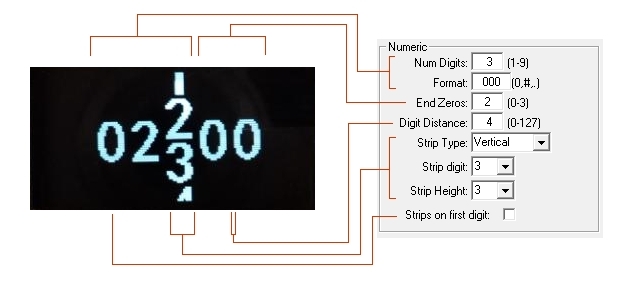
You can choose the function of the display by selecting one of the following types in the pull down menu: Numeric, Digital Watch, Tacan Channel, ILS Frequency, Picture or Level Strip.
Depending on the type selected some other related configurable parameters will appear.
For Numeric, Digital Watch, Tacan Channel, ILS Frequency types, you can adjust the following parameters:

For Picture type you can adjust the following parameters:
The magnitude of the sim has to be selected in the pull down menu “Magnitude”
See some exmaples here
Regards,
Shep
The magnitude of the sim has to be selected in the pull down menu “Magnitude”
See some exmaples here
Regards,
Shep
HOW TO Configure the UHF panel
For UHF Board description, options and how to configure the expander address, see PSCockpit Quick Guide V.4 – UHF PCB. You can access the Quick Guide from Help/Quick Guide menu in the PSCockpit software.
To configure the PS Cockpit UHF panel just select UHF Board from the Expander pull down list in the IOLayout page of the PS Cockpit Software at the correct I2C channel and expander configured in your UHF board:
Once the UHF panel is already configured you can modify the list of inputs/outputs as desire as well as the free I/O of the expander:
Be aware that once the configuration is saved, whenever you enter the IOLayout Page you won’t see “UHF Board” label on the expander anymore but the 40 I/O label.
UHF Frequency and Channel internal values
As BMS do not provide yet the values of the UHF Frequency and UHF Channel in the share memory area, you can choose to use the PS Cockpit Software internal values. This way, you will see the internal values of them displayed fancy in your UHF panel:
To configure the PS Cockpit UHF panel just select UHF Board from the Expander pull down list in the IOLayout page of the PS Cockpit Software at the correct I2C channel and expander configured in your UHF board:
In case of there is some data already in the selected expander, the software will prompt you for continue:
If you have the F16 Model Airplane, you will be prompted to:
- Set the standard BMS commands for the UHF board.
- Link the 7 segment displays to your Airplane model.
- Use internal values for UHF frequency and channel.
If you answer affirmative to the prompts, the UHF board will be ready to use and the F16 Model and Commands pages will show up with all the data already in the correct location:
- Set the standard BMS commands for the UHF board.
- Link the 7 segment displays to your Airplane model.
- Use internal values for UHF frequency and channel.
If you answer affirmative to the prompts, the UHF board will be ready to use and the F16 Model and Commands pages will show up with all the data already in the correct location:
Be aware that once the configuration is saved, whenever you enter the IOLayout Page you won’t see “UHF Board” label on the expander anymore but the 40 I/O label.
UHF Frequency and Channel internal values
As BMS do not provide yet the values of the UHF Frequency and UHF Channel in the share memory area, you can choose to use the PS Cockpit Software internal values. This way, you will see the internal values of them displayed fancy in your UHF panel:
This values will be modified with the encoders of the UHF panel accordingly.
To use this function open the F16 Model page, go to Special I/Os and select “Use UHF Internal Values” and fill the ID of the encoders in its location:
To use this function open the F16 Model page, go to Special I/Os and select “Use UHF Internal Values” and fill the ID of the encoders in its location:
UHF “A” segment display
By default you UHF board is shipped with the first display of the UHF frequency in normal mode. This means that you will see standard numbers in the display. If you would like to see only “2”, “3” and “A” instead, you have to change the configuration of your board as follows:
1. Move the jumper to its original position COM-NORM to ASEG-COM.
2. Wire one free output from the board (by default output 24) with the IN pin of the connector.
By default you UHF board is shipped with the first display of the UHF frequency in normal mode. This means that you will see standard numbers in the display. If you would like to see only “2”, “3” and “A” instead, you have to change the configuration of your board as follows:
1. Move the jumper to its original position COM-NORM to ASEG-COM.
2. Wire one free output from the board (by default output 24) with the IN pin of the connector.
3. In the PS Cockpit Software, select “Use UHF “A” Segment” in the Special I/Os page of the F16 Model and add the output ID in its location:
Power OFF bit
When the board is power ON, the 7 segments displays will display a value of (0). As with the 7 segment display boards, the displays can remain OFF until you energize the pit inside the simulator -as in the real life- using the Power OFF bit.
To use this function, follow the next procedure:
1. Detach the jumper from the Power OFF bit connector of the UHF board.
2. Wire a free output from the board to the left pin of the Power OFF connector (i.e. free output 20):
3. Select a Led Output for the output 20 in the IOLayout.When the board is power ON, the 7 segments displays will display a value of (0). As with the 7 segment display boards, the displays can remain OFF until you energize the pit inside the simulator -as in the real life- using the Power OFF bit.
To use this function, follow the next procedure:
1. Detach the jumper from the Power OFF bit connector of the UHF board.
2. Wire a free output from the board to the left pin of the Power OFF connector (i.e. free output 20):
4. Select “Use Power OFF bit” in the Special I/Os page of the F16 Model and add the output ID in one of the Power Off reserved locations:
Just remember the next time you power ON your cockpit that the board is not faulty but you are using the Power OFF bit!!
Regards,
Shep
Regards,
Shep
HOW TO Configure the Caution Panel
To configure the PS Cockpit Caution Panel just select CP Board from the Expander pull down list in the IOLayout page of the PS Cockpit Software at the correct I2C channel and expander configured in your Caution Panel board (see PSCockpit Quick Guide V.3 – Caution Panel PCB):
Regards,
Shep
In case of there is some data already in the selected expander, the software will prompt you for continue:
If you have the F16 Model Airplane, the software will prompt you to link the CP board to your Airplane Model:
Once the Caution Panel is already configured you can modify the list of inputs/outputs as desire as well as the free I/O of the expander:
Be aware that once the configuration is saved, whenever you enter the IOLayout Page you won’t see “CP Board” label on the expander anymore but the 40 I/O label.Regards,
Shep
Airplane Models in the PS Cockpit System
At this
stage you should be familiar with the F16 Model Airplane configuration page in
the PS Cockpit Software where you can link your switches, leds and other
devices connected to your boards with the specific functions of the F16
Airplane Model. This linkage allows the PS Cockpit Software to know where are
the different elements when running you preferred simulator.
So far, other
two Airplane models have been implemented: A10C and F104G. You can change the
airplane model by clicking the desire option in the Airplane menu of the PS
Cockpit Software main page. The software will ask for confirmation:
Once you
have selected the Airplane Model, next time you click on the Airplane icon on
the left of the main page, the new Airplane Model will be displayed:
Be aware
that although all three airplane models share some configuration data, the
function of some other data may change. Revise carefully the new
configuration!!!
When
changing the Airplane Model no data will be lost.
Regards,
Shep
Subscribe to:
Comments (Atom)

